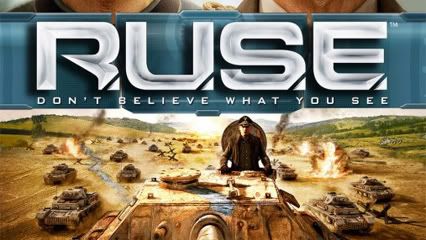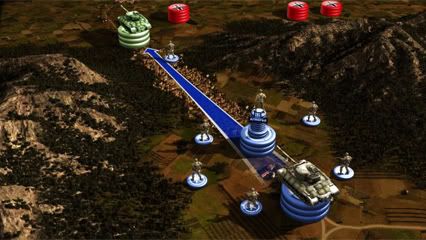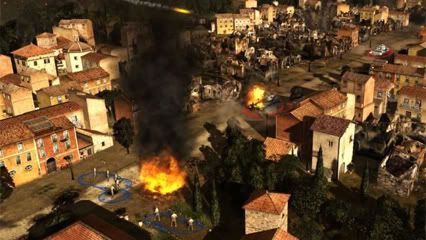 Format: Xbox 360 (version reviewed), PS3, PC
Format: Xbox 360 (version reviewed), PS3, PC- Unleashed: Out Now
- Publisher: Ubisoft
- Developer: Eugen Systems
- Players: 2 – 4
- Site: ruse.uk.ubi.com/
Real-time strategy games are an intriguing genre, as the bare bones of their mechanics have been tested by children trying to better each other in the playground for years. Rock, paper, scissors is the classic example of when one force can cripple a second one, but is highly susceptible to yet another. R.U.S.E. shares some essential elements with everyone’s favourite ‘best out of three’ decision maker – except you can lie about how big your rock is, where your scissors are running off to and why your paper doesn’t seem to exist.
The big difference in this RTS is plastered across the front of the box. A ruse or “crafty stratagem” is a deceptive manoeuvre used to throw your opponent off guard. One of the game’s loading screens puts it nicely as “Make a sound in the east, then strike in the west”.
There is a wide selection of different ruses that can broadly be put into four categories. There are your information gathering ruses that can identify enemy units and their orders, there are concealment ruses that hide your units and movements, ruses for altering unit behaviour, and then there are decoy ruses that make your enemies brown their trousers over a large but fake offensive. You get a steady supply of ruse cards that are topped up periodically over the course of a game, letting you deploy them at regular intervals.

Tanks have never moved subtly to begin with, but that is idiot proof
A good ruse can be a real game changer, especially if your opponent has sent a massive task force to take out what he will soon discover to be a fleet of masking tape and sticky back plastic claiming to be tanks. Sticking real units in with the fakes can also be particularly devastating.
Another parallel that the game shares with rock, paper, scissors is that the large, slower children who believe the rock is unbeatable tend to be the ones who lose. You are going to have to broaden your tactical preferences a lot to succeed in R.U.S.E. as there is no “I win” unit to speak of. There are bigger, more capable versions of standard units, but they still have a very vulnerable Achilles rear panel that the right opponent won’t hesitate to exploit.
For example, infantry get pasted like flies on a tank’s bumper when out in the open. Hide them in the woods however, and they are as good as invisible to basic units. If a tank edges close enough to an infantry squad holed up in a cluster of trees, it can be turned into scrap by short range anti-tank weapons. A more classic example is that planes dominate and rain hell down on tanks, infantry and buildings, but stick some AA guns up and the skies become as accessible as a glory hole with a bear trap mounted on the front.

Fire in the midst of combat can only lead to complications
The campaign does a very good job at slowly easing you into these concepts. You will slowly learn to use each ruse, unit and counter unit, as well as how to overcome them when the guns are turned on you. Realism takes a slight hit when you get to resource collection and base building stages, but it all feels instantly familiar if you have played an RTS before.
Multiplayer comes in typical versus flavour, with team battles and deathmatches included. It adds a nice longevity to the game, as after a while AI ruses can be spotted and dismissed as such. Since people are unpredictable animals, prone to chaos and random excitability, online games will provide a long playing time for any console RTS enthusiast. There are multiple factions including the British, US, Italy and Germany, each with different units and research trees.
Visually, the game has some brilliant concepts. Close to the ground you have units rolling through some beautifully detailed towns and fields, engaging each other in what looks like your typical RTS. Zoom out far enough and you get a tactical overview, very similar to what you can do in Supreme Commander. The fantastic touch they have added to this tactical view however, is that the battlefield becomes a representation of the battle on a table in a war room, complete with ambient office noises. Every unit becomes a coloured counter, slowly dancing to your orders.

So that's how generals sleep at night; war as a board game
You will probably find that most of the time your view will stay somewhere between these two extremes. Close enough to see the layout, but distant enough so that your unit clusters are represented by easy to select tokens. The close up view might be where the action is, but it offers no realistic control. The camera has a habit of jerking towards the action when close to units which can make it hard to do anything in the precise nature that an RTS can sometimes demand.
Controls are always the sticky issue with console RTS games, but R.U.S.E. has done well. It is easy enough to pick up and manipulate large groups of units. Having said this, it is very hard not to feel that controls would be far quicker and more accurate with a mouse in one hand and a drink in the other. Considering this is a technical challenge that the genre has and will always face on consoles however, it is very easy to overlook as once you are accustomed to ordering units around with a pad, it becomes second nature as any game does.
R.U.S.E. can be a lot to take in at first. It seems very daunting for those new to the genre, but a gentle learning curve executed brilliantly in the campaign mode sees you eased in. This does mean that the game seems slow to begin with, but the pace and challenge do start to pick up gradually without overwhelming the player. A lengthy campaign and decent multiplayer options mean that there is plenty to enjoy in a trip back to World War II that doesn’t feel old and done to death.
8/10


















Comments